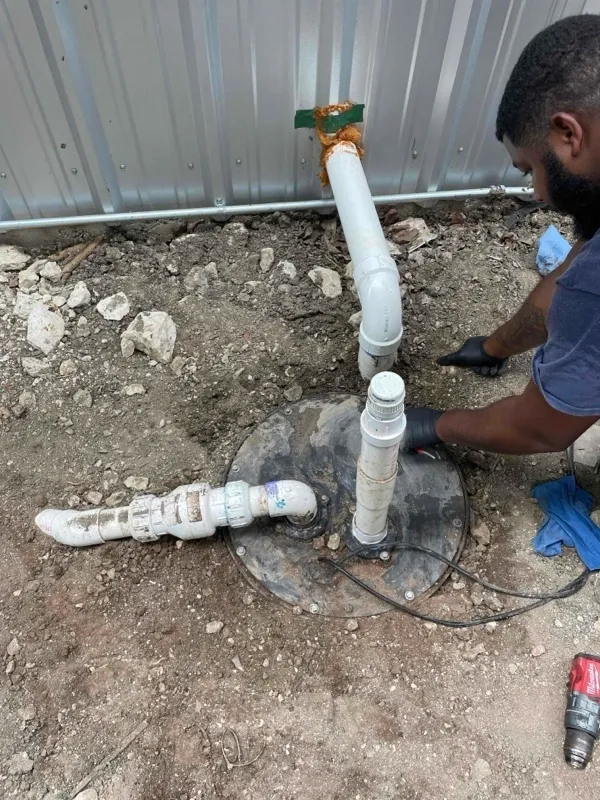What Are Sump Pumps and How Do They Work?

The worst scenario for a homeowner is a flooded home. Your property is shielded by a sump pump from torrential downpours and rising waters that cause significant structural damage and expensive repair bills. Knowing which of the several sumps pumps best suits your needs is crucial. We’ll walk you through a sump pumps operation and how our license professionals determine the best one for your house.
What is a sump pump?
A sump pump is a device that moves water from underneath your home or your basement to the outside of your home. A sump is a pit or hole dug beneath the surface of your basement floor, in the crawl space of a pier and beam home or even in the yard. The pump is kept in this basin-shaped pit. The pump has valves that can detect rising water pressure or level.
How does a sump pump work?
A sump pump monitors rising water levels to make sure they don’t go too high. These pumps employ a switch to when determined the amount of water in the basin is too high. When the switch is tripped it will switch the pump on to start pumping water through a discharge pipe designed to keep water away from the house’s foundation. Water, batteries, or electricity can all be used to power pumps.
Backup pumps are frequently included in sump pump systems, which are typically powered by batteries or water to help in the event of a power outage.
Where should a sump pump drain?
Your sump pump’s water should be directed to a specific location, like a dry well, a creek, pond, or even a nearby drain. A drain point should not be placed where water will return to your house. They are kept at least 10 to 20 feet away from the property’s foundation. It is best to verify with your installing plumber as some city codes have building laws that restrict where your sump pump can discharge.
Remember that you might need to add an additional drainage pipe or boost the sump pump’s horsepower to cover larger areas.
Types of Sump Pumps
There are 4 common types of sump pumps: submersible, pedestal, battery-powered backup, and water-powered backup. Read on to find information on these 4 types of pumps.
- Submersible Sump Pumps – Submersible pumps contain the pump and motor in one unit. They sit submerged and closed inside a basin in your basement. Because submersible pumps are completely submerged in the water basin, they are often quieter, save space in your basement, and clog less than a pedestal. However, due to the effects of water submersion, they may not last as long as other sump pumps. This is still the best option for homes with major flooding concerns.
- Pedestal Sump Pumps – Unlike a submersible sump pump, a pedestal sump pump consists of a separate motor and pump. The motor sits on a pedestal above the basin, with a hose running to the basin where the pump is placed. The pump sends water through the hose and out to your designated drain area. Because the motor is not submerged, it often has a higher lifespan than other sump pumps and can be accessed easier for maintenance issues. However, it also means it can be louder and take up more space than the submersible pump.
- Battery-Operated Backup – A battery backup sump pump is a great way to provide some extra security from flood damage. A battery backup with a float switch allows your sump pump to operate even when your power is out during a storm when you need it the most. When the power goes out the main source of power for the pump does too. Water rises in the basin and the float switch is triggered sending your battery operation into action.
- Water-Powered Backup – A water-powered backup clears the water in your basin through increased water pressure. The advantage of a water-powered system is that there’s no need to monitor the backup or replace any batteries. The use of additional water raises your water bill significantly and is a bit controversial. Some cities do not allow them to be installed.
Are sump pumps necessary?
Sump pumps are necessary in homes prone to flooding or pier and beam homes where water can sit in low areas underneath them. Whether it is from above-average rainfall or basements built below the water table, flooding can be disastrous for your home and your health. Even if your home does not flood, moisture can cause several types of mold that increase the risk for upper respiratory infections, allergic reactions, and asthma complications. If you don’t have a way to move water outside or away from your home, it’s going to accumulate and cause you moisture issues.
ABC Plumbing is your trusted partner in safeguarding your home against flooding with expert sump pump solutions. Whether you need installation, servicing, or emergency repairs, we’re here to help. Benefit from our free estimates and dedicated service for both residential and commercial properties. For after-hours and weekend emergencies, ABC Plumbing is just a call away at (817) 427-3222. Keep your property protected with our reliable sump pump services—Contact Us today!
